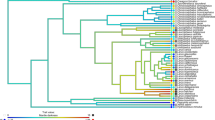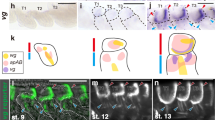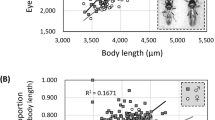Abstract
G. A. MAZOKHIN-PORSHNYAKOV1, examining the optical characters of insect wings in connexion with the visual perception of insects, and taking photographs using ultra-violet rays, found that the smooth, yellow surface of the Gonepteryx rhamni wing has a real pattern which is invisible to the human eye. He also found that such a pattern in the full sense is presented in males only. The wing of the female absorbs ultra-violet rays by the entire surface and then looks dark. Mazokhin-Porshnyakov supposed that this hidden pattern may be considered as a character of taxonomic value. This assumption has been partly supported by my work2.
This is a preview of subscription content, access via your institution
Access options
Subscribe to this journal
Receive 51 print issues and online access
$199.00 per year
only $3.90 per issue
Buy this article
- Purchase on Springer Link
- Instant access to full article PDF
Prices may be subject to local taxes which are calculated during checkout
Similar content being viewed by others
References
Mazokhin-Porshnyakov, G. A., J. Obshchey Biologii, 15, 362 (1954).
Nekrutenko, Y. P., J. Res. Lepid., 3(2), 65 (1964).
Schwanwitsch, B. N., A Course of General Entomology (Moscow–Leningrad, 1949) (in Russian).
Author information
Authors and Affiliations
Rights and permissions
About this article
Cite this article
NEKRUTENKO, Y. ’Gynandromorphic Effect‘ and the Optical Nature of Hidden Wing-pattern in Gonepteryx rhamni L. (Lepidoptera, Pieridae). Nature 205, 417–418 (1965). https://doi.org/10.1038/205417a0
Published:
Issue Date:
DOI: https://doi.org/10.1038/205417a0
This article is cited by
-
Environmental effects on the shape variation of male ultraviolet patterns in the Brimstone butterfly (Gonepteryx rhamni, Pieridae, Lepidoptera)
Naturwissenschaften (2014)
-
Ultraviolet reflection and its behavioral role in the courtship of the sulfur butterflies Colias eurytheme and C. philodice (Lepidoptera, Pieridae)
Behavioral Ecology and Sociobiology (1978)
-
Ultraviolet Differences between the Sulphur Butterflies, Colias eurytheme and C. philodice, and a Possible Isolating Mechanism
Nature (1973)
Comments
By submitting a comment you agree to abide by our Terms and Community Guidelines. If you find something abusive or that does not comply with our terms or guidelines please flag it as inappropriate.



